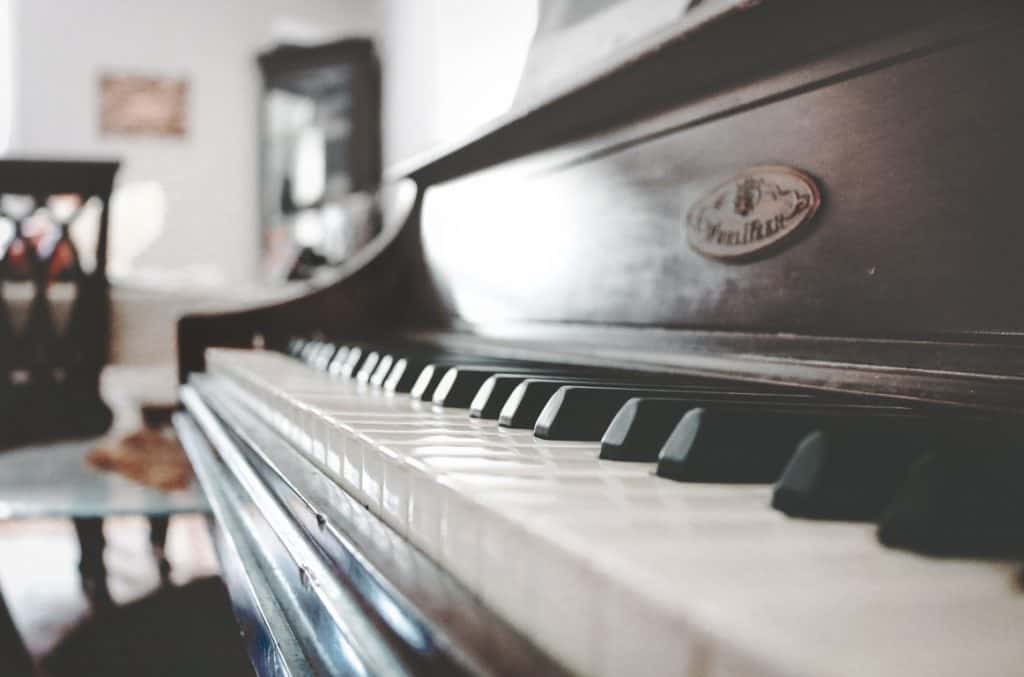Pitch is one of the most fundamental concepts in music and one of the primary ways musicians categorize how a note sounds. A particular sound wave might produce a low pitch, a high pitch, a definite pitch, or an indefinite pitch.
The tools of music theory can be used to analyze these sound waves and transform them into musical melodies with the piano keyboard. Pitch in music is one of the most interesting concepts because it is a meeting point of physics and art, sound wave vibrations and musical notes, and a person’s subjective perception.
Read on to learn more about pitch in music!

What is pitch in music?
Pitch in music refers to the relative frequency of a sound wave. At the basic level, every sound wave produces an oscillating frequency. The sound waves oscillate the air molecules and thus vibrate our eardrums. This is essentially how the human ear hears.
A specific frequency can have a very rapid oscillation or a slower oscillation. A faster oscillation produces a higher pitch while a slower oscillation produces a lower pitch. Frequencies are measured in hertz (oscillations per second) and anytime two sound waves share the same frequency, they share the same pitch.
However, the tone of the specific pitch can be much different depending on which musical instruments are playing! In western music, pitches are often organized with the help of a key signature. For example, the C sharp key signature contains only sharp pitches while the C flat key signature contains only flat pitches.
How to describe pitch in music?
Frequency is the unit of measure of a sound wave, which corresponds to a particular pitch. But, how are the physics concepts of frequencies and oscillations connected to the concept of musical pitch?
Pitch in music can be classified in a few different ways:
- High pitch and higher pitches
- Low pitch and lower pitches
- Definite pitch and definite pitches
- Indefinite pitch and indefinite pitches
Then, there are a handful of other pitch references such as:
- Concert pitch and sounding pitch
- Absolute pitch and relative pitch
Higher frequencies produce higher pitches
A higher frequency produces a higher pitch. On the musical staff, notes considered high pitch notes are generally found above middle c and are notated with treble clef. Which type of instrument produces high pitches? Stringed musical instruments such as violins produce high pitches as do wind instruments such as the oboe and flute.
In written music, high pitch notes are notated using ledger lines above the musical staff. Ledger lines are imaginary lines that music theorists use to notate pitches that do not fit on the normal five lines and four spaces. For example, the C notated on the third space of the treble clef is found one octave higher several ledger lines above the staff.
Lower frequencies produce lower pitches
If you sit down at the piano keyboard and play a low pitch, in which part of the keyboard do you find those different pitches? You find lower pitches at the lower end of the keyboard, below middle C. The notes are low pitches and vibrate at a slower frequency than high pitches.
In the treble clef staff, these low sounds are generally notated below middle C. However, we often use the bass clef in musical notation to label these note names as the bass clef primarily deals with the pitches in the octave lower than middle C.
Which instruments can you think of that produce the lowest frequency tones? String instruments like the double bass and cello produce very low pitches. Other instruments like the tuba and the closely related euphonium, baritone saxophone, and trombone all produce lower pitch notes.
What is a definite pitch?
Definite pitch refers to a musical pitch that can be described with standard music notation. Definite pitches can have a wide range of tones depending on the instrument that produces the sound, but each sound can be called a musical pitch letter name like C, D, E, F, etc. Definite pitches can be combined to develop melody in music.
For example, the notes of the C major scale, chromatic scale, and other piano scales are all definite pitches and can be played by a wide range of instruments. All the tones produced by the white keys on the piano are definite pitches.
What is an indefinite pitch?
Pitches in music that can not be described with traditional musical note names are called indefinite pitches by music theorists. Indefinite pitches have a tone, a duration, and a timbre just like definite pitches. The only difference is they can not be notated with names like C, D, E, F, etc.
For example, the sound of a snare drum is often called an indefinite pitch. There are many sounds found along a guitar string that are indefinite pitches. However, instruments like the piano keyboard do not contain many indefinite pitches when played in a standard way.
What is concert pitch?
Since we have such a wide range of instruments in western music and a huge range of possible pitches and timbres, we often need to compromise and simplify some elements of musical notation.
For example, music written for instruments like the trumpet and the tenor saxophone is notated in two ways: concert pitch and transposing pitch. The trumpet and tenor saxophone are called “transposing instruments” meaning that the written music for those instruments is notated differently than music for the piano keyboard for example,
When written in transposing pitch for the B flat trumpet, the C major scale actually begins with the pitch D. This is because the music for the B flat trumpet is notated two half steps higher than it sounds.
Absolute pitch versus relative pitch
Finally, we have the concepts of absolute pitch and relative pitch. Both of these ideas come from the realm of aural skills, or the development of our ears to hear and identify specific elements of music such as pitches, intervals, chords, etc.
Absolute pitch refers to the ability to hear any note or harmony in music and name it without a reference pitch. This ability is rather rare in the world and does not directly correlate to skill as a musician.
Relative pitch refers to the ability to hear and identify piano notes, chords, melodies, etc. with the help of a reference pitch. For example, you can memorize a pitch like middle C and then compare all other pitches to this pitch. Anyone can learn to develop strong relative pitch by steady and consistent practice.
What is the difference between tone and pitch?
Finally, it is important to draw a distinction between tone and pitch in music. Tone generally refers to more aesthetic qualities of a sound such as the quality of the sound, the timbre of the instrument, the relative strength and intensity of a sound, and any other overall characteristics. Contrast this with pitch which primarily deals with the frequency of a sound, its relative speed of oscillation, or how high or low the note sounds.
Bringing it all together
Pitch in music primarily refers to the relative frequency of a particular tone. A higher pitch, like a sound made by a trumpet or flute, has a higher frequency than a lower pitch, like a sound made by a double bass or cello.
All musical instruments produce pitches, however not all pitches can be notated using standard music notation. Pitches that cannot be notated in a standard manner are called indefinite pitches.
You can become a master of all things relative to pitch with online piano lessons from Skoove. Develop your skills of recognizing, naming, and reading pitches on the piano with Skoove’s intuitive lesson plans. Have fun and enjoy the benefits of music education with a 7 day free trial of Skoove! Remember – it’s all just vibration!
Author of this blog post:

Eddie Bond is a multi-instrumentalist performer, composer, and music instructor currently based in Seattle, Washington USA. He has performed extensively in the US, Canada, Argentina, and China, released over 40 albums, and has over a decade experience working with music students of all ages and ability levels.














